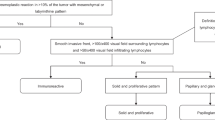Abstract
Purpose
To evaluate the prevalence of regional lymph node (LN) metastasis in patients with non-clear cell epithelial ovarian cancer apparently confined to the ovary, stratified by tumor grade.
Methods
The National Cancer Institute’s Surveillance, Epidemiology, and End Results (SEER) database was accessed (1988–2014). We identified patients with epithelial ovarian carcinoma of serous, endometrioid and mucinous histology apparently confined to the ovary who underwent extensive lymphadenectomy (defined as at least 20 lymph nodes removed). Demographics, tumor histology, grade and lymph node status were collected. Comparisons were made with Chi square and Mann–Whitney U tests.
Results
A total of 1242 women met the inclusion criteria. Endometrioid adenocarcinoma was the most common histology (564 patients (45.4%)) while 443 (35.7%) and 235 (18.9%) patients had serous, and mucinous adenocarcinoma, respectively. The rate of LN metastasis in low-grade serous was 9.0% (6/67) vs. 14.4% (54/376) in high-grade serous histology (OR, 1.71, 95% CI 0.70, 4.14, p = 0.24). In patients with low-grade endometrioid tumors, the rate of LN metastasis was 1.7% (7/407) vs. 5.1% (8/157) observed in those with high-grade tumors (OR: 3.07, 95% CI 1.09, 8.61, p = 0.033). Lastly, the rate of LN metastasis in mucinous histology was 1.7% (3/177) in low-grade vs. 8.6% (5/58) in high-grade tumors (OR: 5.47, 95% CI 1.27, 23.66, p = 0.024).
Conclusions
Regional LN metastasis in apparent stage I low-grade mucinous and endometrioid ovarian tumors is infrequent.

Similar content being viewed by others
References
Siegel RL, Miller KD, Jemal A (2015) Cancer statistics, 2015. CA Cancer J Clin 65:5–29. https://doi.org/10.3322/caac.21314
Young RC (2003) Early-stage ovarian cancer: to treat or not to treat. J Natl Cancer Inst 95(2):94–95
Winter-Roach BA, Kitchener HC, Dickinson HO (2009) Adjuvant (post-surgery) chemotherapy for early stage epithelial ovarian cancer. Cochrane Database Syst Rev. https://doi.org/10.1002/14651858.CD004706.pub3
Kleppe M, Wang T, Van Gorp T et al (2011) Lymph node metastasis in stages I and II ovarian cancer: a review. Gynecol Oncol 123(3):610–614
Surveillance, Epidemiology, and End Results (SEER) Program Research Data (1973–2015), National Cancer Institute, DCCPS, Surveillance Research Program. https://www.seer.cancer.gov
Cancer Incidence in Five Continents Vol.X IARC Scientific Publication No 164, 2014 Chapter 4, p84
Gockley A, Melamed A, Bregar AJ, Clemmer JT, Birrer M, Schorge JO, Del Carmen MG, Rauh-Hain JA (2017) Outcomes of women with high-grade and low-grade advanced-stage serous epithelial ovarian cancer. Obstet Gynecol 129(3):439–447
Lago V, Minig L, Fotopoulou C (2016) Incidence of lymph node metastases in apparent early-stage low-grade epithelial ovarian cancer: a comprehensive review. Int J Gynecol Cancer. 26(8):1407–1414
Minig L, Heitz F, Cibula D et al (2017) Patterns of lymph node metastases in apparent stage i low-grade epithelial ovarian cancer: a multicenter study. Ann Surg Oncol 24(9):2720–2726
Kaldawy A, Segev Y, Lavie O, Auslender R, Sopik V, Narod SA (2016) Low-grade serous ovarian cancer: a review. Gynecol Oncol 143(2):433–438
Nasioudis D, Chapman-Davis E, Witkin SS et al (2017) Prognostic significance of lymphadenectomy and prevalence of lymph node metastasis in clinically-apparent stage I endometrioid and mucinous ovarian carcinoma. Gynecol Oncol 144(2):414–419
Funding
The authors declare no source of funding for the research conducted.
Author information
Authors and Affiliations
Contributions
DN: Conception, Protocol/project development, Data collection and management, Data analysis, Manuscript writing/editing, SAM: Data analysis, Manuscript writing/editing, EMK: Data analysis, Manuscript writing/editing, NAL: Protocol/project development, Data analysis, Manuscript writing/editing.
Corresponding author
Ethics declarations
Conflict of interest
All authors declare no potential conflict of interest, including and financial or personal relationship which could viewed as one.
Ethical standards
The SEER is a public dataset available to the public for research purpose. All patient data are de-identified. The present study was deemed exempt by the institutional review board.
Rights and permissions
About this article
Cite this article
Nasioudis, D., Mastroyannis, S.A., Ko, E.M. et al. Does tumor grade influence the rate of lymph node metastasis in apparent early stage ovarian cancer?. Arch Gynecol Obstet 298, 179–182 (2018). https://doi.org/10.1007/s00404-018-4789-2
Received:
Accepted:
Published:
Issue Date:
DOI: https://doi.org/10.1007/s00404-018-4789-2




